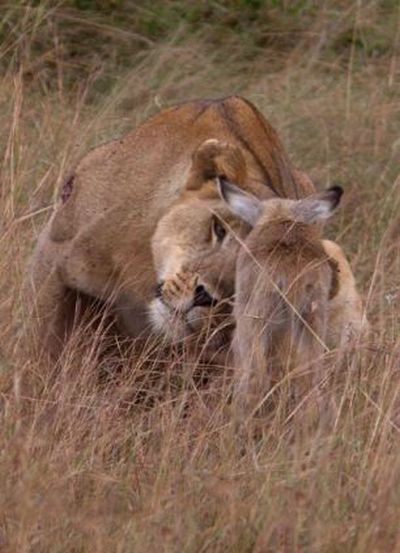|
|
Wounded Lioness Adopts Baby Antelope After Killing Its Mother
|
Antelopes have a wide variety of coverings, through most have a dense coat of short fur. In most species, the coat (pelage) is some variation of a brown colour (or several shades of brown); often with white or pale under-bodies. Exceptions include the zebra-marked Zebra Duiker; the grey, black, and white Jentink's Duiker; and the Black Lechwe. Most of the "spiral-horned" antelopes have pale vertical stripes on their backs. Many desert and sub-desert species are particularly pale, some almost silvery or whitish (e.g. Arabian Oryx); the Beisa and Southern Oryxes have gray and black pelage with vivid black-and-white faces. Common features of various gazelles are a white rump, which flashes a warning to others when they run from danger, and a dark stripe mid-body (the latter feature is also shared by the Springbok and Beira). The Springbok also has a pouch of white brushlike hairs running along its back, which opens up when the animal senses danger, causing the dorsal hairs to stand on end.
Antelopes are ruminants, and thus have well-developed molar teeth, which grind cud (food balls stored in the stomach) into a pulp for further digestion. They have no upper incisors, but rather a hard upper gum pad, against which their lower incisors bite to tear grass stems and leaves.
Like many other herbivores, antelopes rely on keen senses to avoid predators. Their eyes are placed on the sides of their heads, giving them a broad radius of vision with minimal binocular vision. The fact that most species have their pupils elongated horizontally also helps in this respect. Acute senses of smell and hearing, give antelope the ability to perceive danger at night out in the open (when predators are often on the prowl). These same senses play an important role in contact between individuals of the same species: markings on head, ears, legs, and rumps are used in such communication—many species "flash" such markings, as well as their tails; vocal communications include loud barks, whistles, "moos" and trumpeting; many species also use scent marking to define their territories or simply to maintain contact with their relatives and neighbors.
Many antelope are sexually dimorphic. In most species, both sexes have horns, but those of males tend to be larger. There is a tendency for males to be larger than the females; however, exceptions in which the females tend to be heavier than the males include the Bush Duiker, Dwarf Antelope, Cape Grysbok, and Oribi, all rather small species. A number of species have hornless females (e.g. Sitatunga, Red Lechwe, and Suni). In some species, the males and females have different coloured pelage (e.g. Blackbuck and Nyala).
|
|









